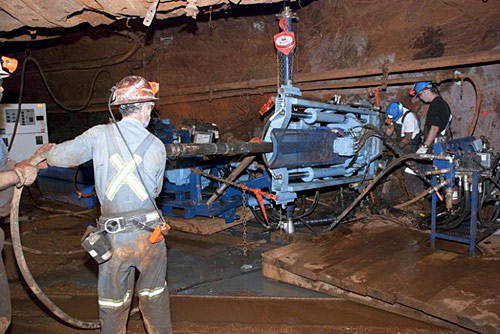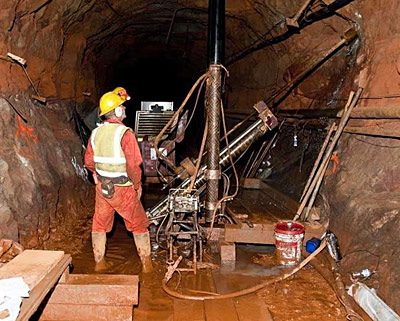NSF authorizes $29 million for world's deepest underground lab
The National Science Foundation (NSF) has authorized more than $29 million for the University of California, Berkeley, to create a preliminary plan for turning a former gold mine in South Dakota into the world's deepest laboratory.

The grant, approved Sept. 24 by the National Science Board, is for a preliminary design of the Deep Underground Science and Engineering Laboratory (DUSEL), a facility at the former Homestake gold mine in Lead, S.D. The laboratory would consist of underground labs and above-ground buildings to host physics, engineering, geoscience and biology experiments that can only be conducted under thousands of feet of rock, as deep as 8,000 feet.
The rock would shield physics experiments from cosmic ray particles that would swamp detectors looking for rare events, while the mine's 600 kilometers of tunnels would allow access to microbes and geological areas not otherwise possible.
"NSF has put forward nearly $30 million and, in addition, provided $21 million more to explore 16 possible experiments, so they are embracing DUSEL very firmly," said Kevin Lesko, UC Berkeley adjunct professor of physics and principal investigator for the project.
Of the $29.1 million, nearly $13 million will be directed to the South Dakota School of Mines and Technology for major design contracts being managed there for the project and $370,000 to Lawrence Berkeley National Laboratory. The preliminary design for the underground laboratory would be part of a proposal submitted to the board in the spring of 2011 in anticipation of funds to start construction in fiscal year 2013.
Construction is already underway at the mine after the June dedication of the Sanford Underground Science and Engineering Laboratory, which is supported by $70 million from South Dakota banker and philanthropist T. Denny Sanford. In all, more than $120 million of non-NSF funding has been committed to rehabilitating the shafts and pumping and treating water from flooded depths to prepare the site for DUSEL.
The Sanford Lab, located at a depth of 4,850 feet, will house the first experiments: the Large Underground Xenon (LUX) experiment, which will look for dark matter; and the Majorana Demonstrator, which will search for neutrinoless double beta decay. If the NSF approves construction funds, DUSEL is expected to absorb and maintain the Sanford Lab as additional research space is prepared at the 4,850-foot and 7,400-foot levels.
"We are pursuing some of the most exciting aspects of several different disciplines simultaneously; not just experiments on dark matter, but experiments on neutrinos and in the areas of nuclear astrophysics and geomicrobiology, all in one facility," Lesko said. "We will exploit the synergies between those different disciplines."

In 2007, when the NSF selected the Homestake site for a national deep underground lab, the agency also chose the UC Berkeley team to develop key elements of the preliminary design and refine the lab's proposed scientific, educational and engineering goals. The campus submitted in May of 2009 a proposal to complete the preliminary design of research areas in chambers at the 7,400-foot and 4,850-foot levels, as well as to support space on the surface. Working with Lesko are project director Kem Robinson and co-principal investigator William Roggenthen of the South Dakota School of Mines and Technology.
"By the end of next summer, we hope to complete a preliminary design of the facility and then integrate with it a generic suite of experiments," Lesko said. "While formal selection of the experiments will not have been made by that time, we know enough about them now that we can move forward with the preliminary design."
In preparation for the design work, more than 200 potential DUSEL researchers met in the city of Lead Sept-30-Oct. 3 to attend the first meeting of scientific users. At that meeting, the UC Berkeley and South Dakota team began gathering the scientific requirements from users for integration into the proposal. The users include not only the 16 collaborations chosen by the NSF to develop conceptual designs, but more than a dozen other collaborations. In addition to the physics and astrophysics experiments, these include studies of the fracture network in rock and searches for exotic forms of life at the extreme temperatures and pressures underground.
The DUSEL team continues to work closely with the South Dakota Science and Technology Authority, financed by Sanford and the state of South Dakota. The SDSTA manages the rehabilitation of the Homestake site and the creation of the Sanford Lab.
